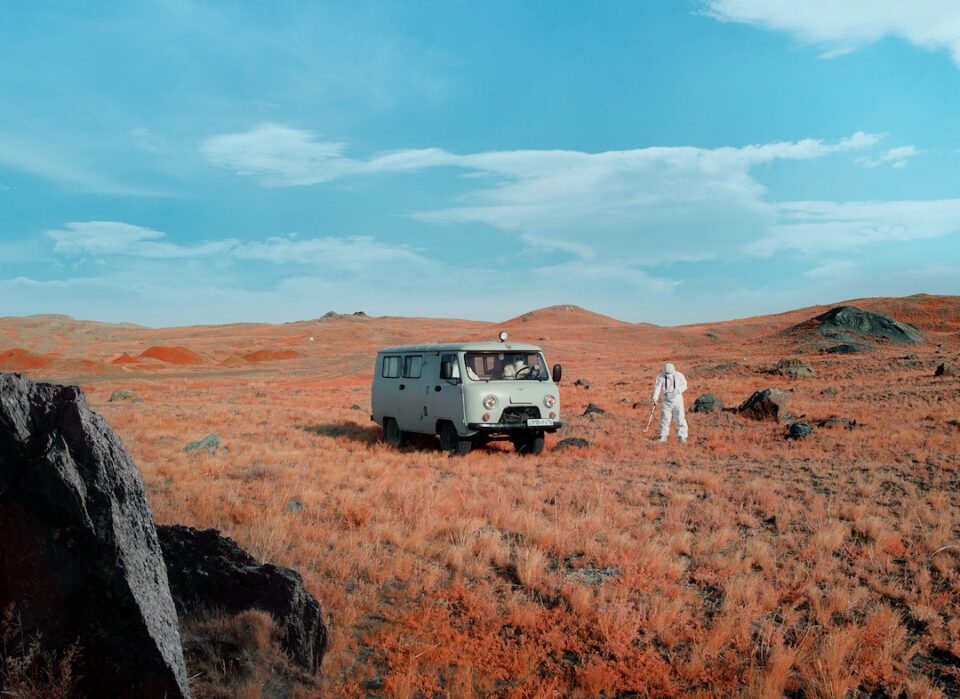Between 1949 and 1989, the Semipalatinsk Test Site was the largest nuclear research area in the former Soviet state of Kazakhstan. The Nuclear Threat Initiative reports more than 450 experiments were conducted, including 340 underground and 116 atmospheric explosions. Soviet authorities withdrew in 1991, yet the effects on nature and the population are felt to this day. With a Geiger counter and a medium-format camera, documentary photographer Eddo Hartmann (b. 1973) has visited the region five times since 2018, traversing radioactive grassland steppes, building sites and abandoned cities. Now showing at Huis Marseille, Amsterdam, the collection shines a piercing light on a place irradiated beyond repair, where destructive events from the past are burnt into the landscape we see today.
A: Tell us about how you got started with this body of work – where did it all begin?
EH: This project is essentially a culmination of several ideas. I had previously come across the concept of “sacrifice zones” – areas once occupied by regimes that have now been taken over by large corporations. These spaces are used by companies to conduct secretive activities away from the world’s view. For a long time, I didn’t know how to draw attention to this issue. Then, I began my search for one of the first such areas ever created. It led me to this vast nuclear test area in Kazakhstan.
A: What’s the focus or message behind this latest exhibition at Huis Marseille?
EH: Over time, it seems that the entire world is becoming a “sacrifice zone” for humanity. Nature and the environment are almost always destroyed for short-term gains, resulting in large-scale ecocide. In Kazakhstan, the Soviet regime designated a vast portion of the steppe as a nuclear test site until the early 1990s, making it one of the first and most notorious. I wanted to share this relatively unknown story.

A: Do you have a favourite piece in the show?
EH: One of the first portraits I created for this project was of a man in a blue suit and a gun in his hands. He was appointed by authorities to protect old military installations from local gangs. He lived beneath a massive radar installation and had a small garden and some livestock. I was deeply impressed by his hospitality and the way he described his life and work in this desolate place. It confirmed for me that I needed to tell his story – and that of these testing areas – to a larger audience.
A: Who – or what – are your biggest inspirations?
EH: I draw most of my inspiration from books and documentaries, occasionally from visual art, but rarely from photography. I seem to learn the most from other disciplines and enjoy immersing myself in works from entirely different worlds.
A: What’s been the highlight of your career so far?
EH: The opportunity to travel to unfamiliar places, to hear untold stories and document them is extremely valuable to me – whether it’s in North Korea or Kazakhstan. I don’t really think I can share a single standout moment; it’s more a collection of remarkable experiences during projects that have stayed with me. This time it was being confronted with this enormous steppe – a combination of awe and fear.
A: Do you have a “signature” technique or approach? What is it?
EH: Overall, I aim to tell my stories as simply as possible, with just a few elements in the frame. I strive to convey something that isn’t always easy to express. I’m constantly on the lookout for places that may not seem significant at first glance, have more to them than meets the eye.

A: If you could do any other job, or be an expert in any other field, what would it be?
EH: I enjoy building things, such as furniture and interiors, and I’ve worked on set designs for film and photography. I could easily pursue a second career in this, but my first love is photography.
A: Who are your favourite artists working right now?
EH: The work of filmmakers and cinematographers like Roger Deakins and Hoyte van Hoytema fascinates me. Their use of light and the visual storytelling techniques they employ are highly admirable to me.
A: Is there anything you hope audiences take away from the show?
EH: I hope to raise awareness and demonstrate that complex issues have various facets. People often hold strong opinions about subjects where there seems to be no room for subtlety. The media might serve the news in a few catchy headlines, but taking a little more time reveals that everything is much more nuanced.
A: What are you working on right now? Anything for us to look forward to?
EH: Just a few weeks ago, I completed The Sacrifice Zone, opening the Huis Marseille show and publishing a book. I need some time to distance myself from this project before I can move on to the next one. I have some assignments that I need to take on; this last project was like always quite demanding on my finances and private life. I have some rough ideas for new projects, but nothing is very clear yet.
The Sacrifice Zone runs until 25 February | huismarseille.nl
Image Credits:
1. © Eddo Hartmann. Grey Bukhanka, Lake Shagan, Kazakhstan, 2023.
2. © Eddo Hartmann. Red Horse, Sarzhal, Kazakhstan, 2019.
3. © Eddo Hartmann. Black Pylon, Polygon, 2022.





